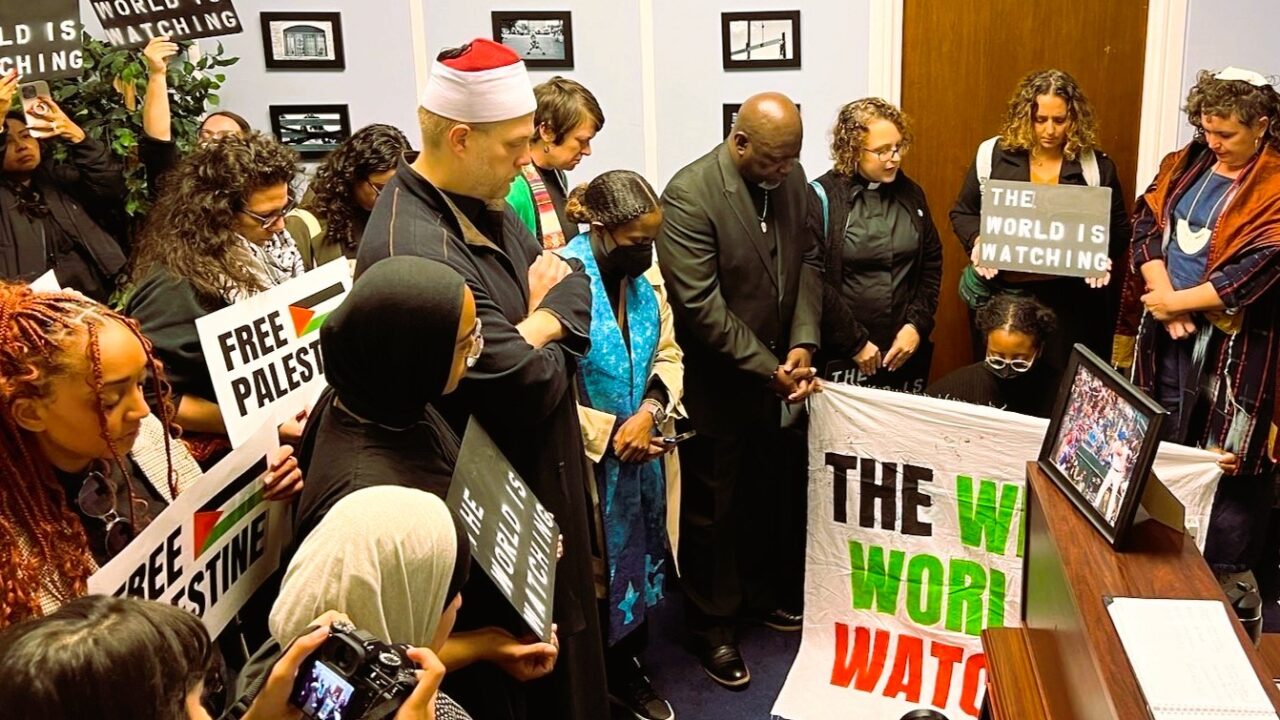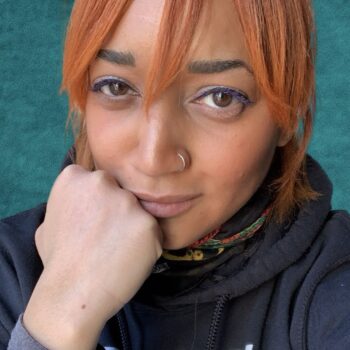Social justice movements often struggle to achieve long-term systemic change because they fail to effectively engage and sustain collective action. Without a cultural strategy that shapes public perception and builds emotional and ideological commitment, movements risk losing momentum or failing to mobilize broad support. Cultural strategy is the intentional use of culture—such as art, music, storytelling, and rituals—to engage people’s beliefs, values, and perceptions in order to support social and political movements. It involves shaping the collective consciousness of a society by shifting the narratives and emotional frameworks through which people understand the world, with the ultimate goal of inspiring and sustaining action toward systemic change. Art and culture are not just supplementary elements in social movements; they are crucial to the strategic development of these movements.
“In the Movement there was a transformation that took place inside of people, and the singing echoed it. If people are transformed, they create the sound that lets you know they are new people. It is a sound you’ve never heard before, and they have never heard it before, because they’ve never been in that place before.” – Dr. Bernice Johnson Reagon
The late Dr. Bernice Johnson Reagon, often emphasized the transformative power that singing especially has in developing leaders in movement, suggesting that as people change, their singing reflects this inner transformation with a new and unique sound. Throughout history—whether in the fight against slavery, Civil Rights marches, labor union strikes, or global resistance movements—music has played a central role. It not only spreads the movement’s message but also strengthens its resilience. In my experience, music has the unique ability to connect us on a deep emotional level, bridging gaps that words alone may not. At the Kairos Center for Religions, Rights, and Social Justice, where I work, cultural strategy is central to our organizing efforts. We define cultural organizing as placing culture at the center of our organizing strategy to shift the narrative by shifting the narrators (tell our stories) and build power (develop leaders and win the middle). We use art to change narratives that blame the oppressed for their own suffering and to build collective power by identifying, developing, and uniting leaders from across historic divides.

In this piece, I will reflect on the use of cultural organizing over the past year to demand a permanent ceasefire, a free Palestine, and an arms embargo to end Israel’s genocide in Gaza. I have deep connections to Palestine rooted in my organizing experience with the Dream Defenders, Black 4 Palestine, Black Christians for Palestine and other efforts. In January 2015, I joined a transformative journey to Palestine with the first Dream Defenders delegation with the purpose of strengthening solidarity between Black and Palestinian communities.
I returned to Palestine in July of 2023 with a multi-racial delegation of faith leaders and organizers led by Rev. nyle fort and Jonathan Kuttab of Friends of Sabeel, North America (FOSNA). FOSNA is an interdenominational Christian organization that forwards the vision of Sabeel Jerusalem, an ecumenical liberation theology movement founded by Palestinian Christians in the Holy Land.

On this latest visit, during a particularly heavy day of touring Hebron, we were hosted for lunch by a local Palestinian family. Hebron was once the economic center of Palestine but after decades of Israeli occupation and settler violence—including a massacre at Ibrahimi Mosque in 1994 by Brooklyn born and raised IDF physician, Baruch Goldstein—it is a city under a repressive military occupation supported by tremendous violence against the Palestinian communities carried out by illegal settlers. Learn more about the impact of the massacre in the local community from our tour guide here.
Spending a couple of hours with the family in Hebron felt like a spiritual refuge from the evil that was being committed outside of their home. The checkpoints and the constant interrogation by Israeli soldiers were all around us, along with vicious Israeli settler graffiti, jeers, weaponry, and literal trash that littered not only the streets but the sky above. Check out our tour guide explaining this experience here.
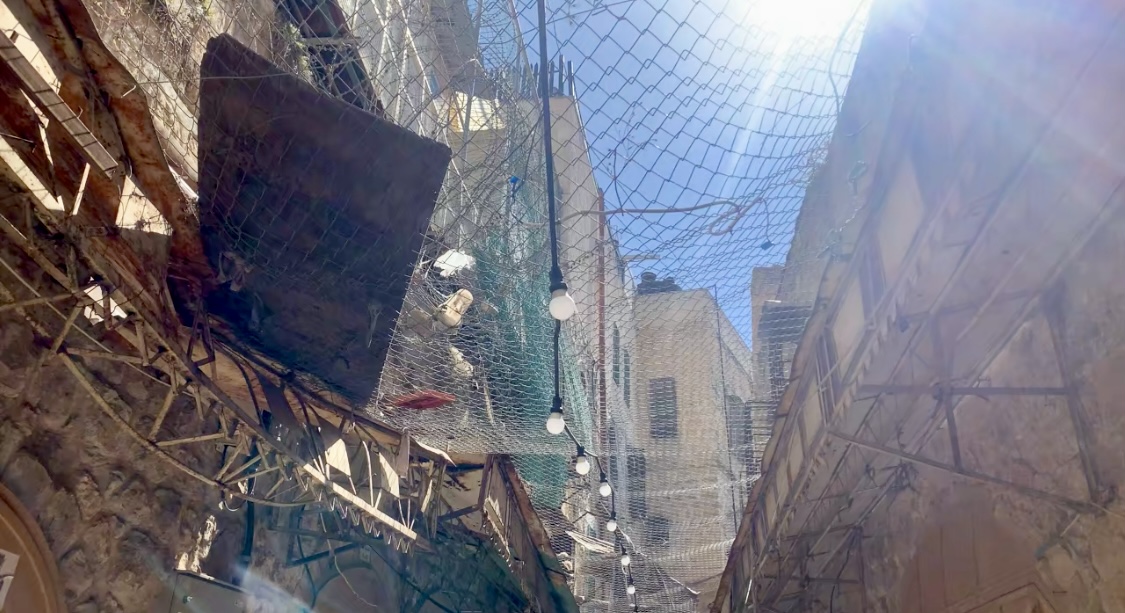
Although we had an incredible translator with us, we wanted to be able to communicate more deeply than words alone would allow. We wanted our hosts to feel how grateful we were for their hospitality, to bear witness to the occupation, and to share strength. We wanted them to know that we are in solidarity with them and will carry them with us in our hearts, minds, and actions as we continue our collective struggle. After a quick huddle to decide how to go about this, we decided to sing.
Dr. Charon Hribar, a colleague of mine at the Kairos Center, often emphasizes that singing together aligns our breaths and heartbeats, creating a shared sense of solidarity that transcends language barriers. To illustrate our commitment to solidarity with the Palestinian people under Israeli Apartheid, we chose the song, “Courage”. Courage is a song that comes out of the movement to end Apartheid in South Africa. Leaders of that struggle would substitute the word “courage” with the names of political prisoners to learn each other’s names and remember one another. It was a way of expressing solidarity even as they were separated or in isolation without human contact nor ability to see outside their walls. It was a way of reminding each other to have courage in the face of immense violence and that they were not alone. Despite the oppressive environment in Hebron, sharing songs with our Palestinian hosts helped bridge the gap between different cultures and experiences, reinforcing our mutual solidarity.
Courage, my friend
You do not walk alone
We will walk with you
And sing your spirit home
Watch us sing to our Palestinian host family here.
Cultural organizing involves selecting art forms that resonate with the spirit of struggle, engage in a battle of ideas, and focus on building power through developing strong leaders. The Kairos Center’s cultural strategy emphasizes Willie Baptist’s 4 C’s of Leadership Development: clarity, competence, connection, and commitment. Clarity involves understanding the root causes of oppression and articulating them effectively. Competence requires developing strategic skills and knowledge to achieve goals. Connection means uniting leaders from various backgrounds and experiences to build a cohesive movement, while commitment involves dedicating oneself to the movement’s long-term objectives.
Exploring the 4 C’s with “Courage”
Clarity. At the Kairos Center, clarity means understanding the core of a situation by going beyond superficial appearances to uncover root causes. This approach, articulated in Albert Turner’s concept of the “root doctor,” highlights the importance of recognizing and addressing systemic issues rather than merely addressing symptoms.
The mind is a crucial battleground in social conflicts, shaped by deeply ingrained values and prejudices influenced by upbringing, education, media and policy. Understanding these mental variables is essential for addressing systemic oppression effectively. In the conflict with the Israeli occupation of Palestine, for example, Zionism is often misrepresented as synonymous with Judaism, and Palestinians are wrongly equated with Islam, framing the conflict as a timeless religious war. In reality, Zionism is a political ideology, not a religion, and many Palestinians are Christian.
Furthermore, Christian Zionists, who support Jewish nationalism based on their interpretation of the Bible, actually outnumber Jewish people (both Zionist and anti-Zionist combined). Their interpretation, which can be viewed as anti-Semitic itself, manipulates Jewish identity and interests for their political purposes. To learn more about Christian Zionism, check out this helpful 101 by Political Research Associates.
Historically, religion has been used both to uphold the status quo and to challenge it. Christianity in the U.S. has been employed to justify both economic exploitation and liberation movements. Examples of this may be found in the use of certain Biblical passages by slaveholders and abolitionists alike in the movement to end slavery. Just as Frederick Douglass, Harriet Tubman, and many revolutionaries before us, it’s incredibly important that we address both the ideological uses/misuses of religion and cultivate a moral and social framework that supports and validates the struggles for liberation of the oppressed over the oppressor.
In witnessing the brave actions already being taken by Jewish and Muslim leaders from organizations like Jewish Voice for Peace, If Not Now, American Muslims for Palestine (AMP), and more, Sandra Tamari, a Palestinian Christian and executive director of the Adalah Justice Project, knew that we needed to also engage Christian leaders in the moral call for a permanent ceasefire, a free Palestine, and an arms embargo to end Israel’s genocide in Gaza. Understanding that solidarity must be grounded in collective action, the Adalah Justice Project along with the US Campaign for Palestinian Rights, the Kairos Center, Movement for Black Lives, Rising Majority, Jewish Voice for Peace, Rabbis for Ceasefire and others brought together 40 faith leaders for a multi-faith pray-in at Rep. Hakeem Jeffries’ office.
The pray-in action combined spiritual practices, faith traditions and a righteous call for political action. In preparation for the pray-in, participants engaged in prayers, meditation, breathing exercises, and stretches led by spiritual leaders and healers. The D.C. Apothecary, established during the 2020 uprisings for Breonna Taylor and George Floyd and the COVID-19 pandemic, provided tinctures to support attendees. Organizers, spiritual leaders and clergy from across different traditions marched from a local church to the Capitol to visit Rep. Jeffries’ office.
One lesson from Kwame Ture (Stokely Carmichael) on the role of an organizer has stuck with me over the years. He said something to the effect that the responsibility of the revolutionary is not to make the unconscious conscious, but to make the unconscious conscious of their unconscious behavior. At the Kairos Center, we have found ritual to be key in developing consciousness. We define ritual as an intentional and symbolic action that springs from, evokes, and develops complex and often deep layers of feeling and thought. It is grounded in our lived experience: our stories, our needs, our authority, and our desires. As such, ritual carries the values and intentions of a given community and can help deepen and repair relationships to one another and to the world around us. Rituals deepen relationships within the movement and anchor people in the cause, especially during hard or uncertain times.
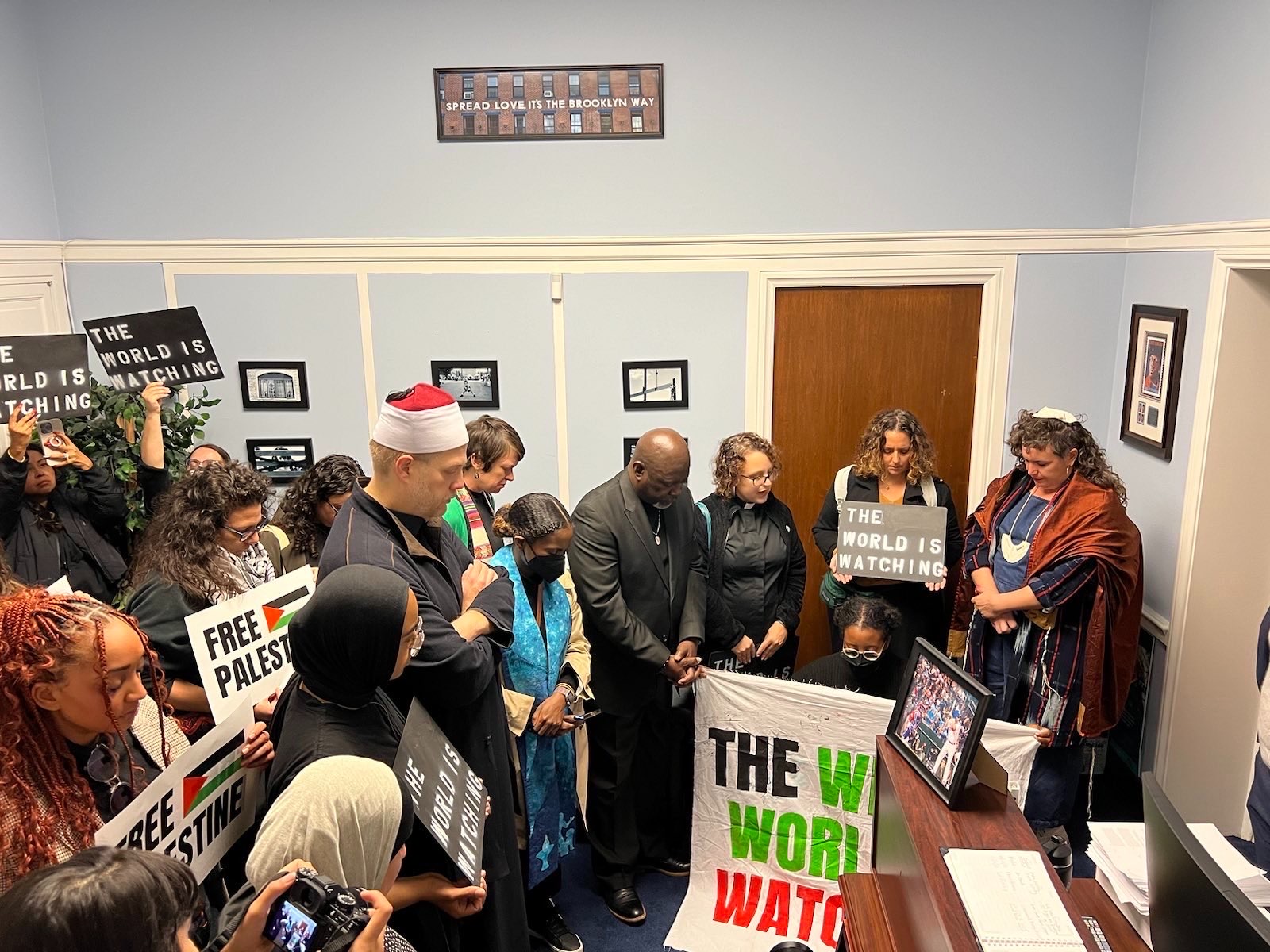
In planning our pray-in, we employed aspects of rituals from different religious, spiritual, and organizing practices by consciously engaging as many of the senses as possible. Visually, the pray-in featured banners that used the colors of the Palestinian flag and featured messages like “ceasefire is the moral choice” and “the world is watching,” based on a chant that Sandra created the day before. Red was chosen for “ceasefire” to symbolize the red used in stop signs, while green for “moral choice” represented life, health, and the path forward in ending genocide. Mirrors were used on the backs of some of the signs to reflect back to the staff members (and, in a way, to remind ourselves) that we are the ones who must choose to call for an end to the devastation in Gaza. Faith leaders wore religious attire to showcase the multi-faith nature of our action.
Sandra always makes a point to read off the names of those who have been killed as a result of the US funded Israeli war on the Palestinian people of Gaza. Intermittently, we also included prayers from various faith traditions, and we used more songs instead of chants, following feedback from Rep. Jeffries’ staff about the sensitivity of chants due to the January 6th Capitol riot.
Although it may feel strange now for us to have forgo the use of chants during the pray-in, we were very clear in these early days of the atrocities being committed against Palestinians in Gaza that Rep. Hakeem Jeffries’ staff was not our enemy but rather people who had yet to make the moral choice to call for a ceasefire. In closing our pray-in we shared the song “Courage”.
Courage, my friend
You do not walk alone
We will walk with you
And sing your spirit home
Watch the recap of our pray-in led by the Adalah Justice Project here.
Competence. At the Kairos Center, we define competence as being in possession of the strategic and tactical (long and short terms, staircase and steps) skill sets, knowledge, qualifications, and/or capacity to accomplish what is required.
In a debrief of our action, I sat with Sandra and Audrey Bruner of Adalah Justice Project, Paige Ingram of the Movement for Black Lives, and Iman Abid-Thompson of US Campaign for Palestinian Rights and asked them what was needed to support organizers in the call to end the genocide in Gaza at that point. A couple of things that rose to the top was a need to engage more Chrisitians and a means to exchange cultural resources across various sections of the movement that are rising up in protest.
In witnessing the incredible amount of art and culture that was being infused into actions and protests for ceasefire and the organic exchange of resources from various artforms, we knew that it wouldn’t be enough to collect only songs for this cultural resource, but to capture songs, chants, poetry, prayers, and visual forms of artwork that can be used in the call for a permanent ceasefire, a Free Palestine, and an arms embargo to end Israel’s genocide in Gaza.
Sandra connected me to Ryah Aqel, a Palestinian Michigan-based artist who worked on previous projects with Adalah Justice Project and who was also able to put us in touch with the graphic designers Wesley Taylor, Una Lee, and Aya Krisht. They took on the task of designing both a physical layout and digital version of the book that can be accessed via computer or by phone. They made sure the Arabic was on point in the guide and Ryah also helped capture open-source visual resources. For poetry, I reached out to Tariq Luthun, a Palestinian poet and cultural organizer from Gaza who shared some of his poetry during the “Pray for the Dead, Fight for the Living” multi-faith rally and Zaina Alous, a Palestinian poet and labor organizer that I knew through organizing with the Dream Defenders and FemPower MIA who also helped gather chants in Spanish that she heard in the streets.
For songs, prayers, and visual resources I had with me Charon Hribar, the Cultural Strategies Director for the Kairos Center. We have been organizing for years together through the Poor People’s Campaign: A National Call for Moral Revival Theomusicology and Movement Arts team that she co-leads. With this team we also engaged leaders from our broader network for cultural resources like Jewish Voice for Peace, US Campaign for Palestinian Rights, If Not Now, Southerners on New Ground (SONG), Movement 4 Black Lives, Rising Majority, I Witness Silwan, Peace Poets, Showing Up for Racial Justice (SURJ), and others who in turn also reached out to their networks for additional materials.
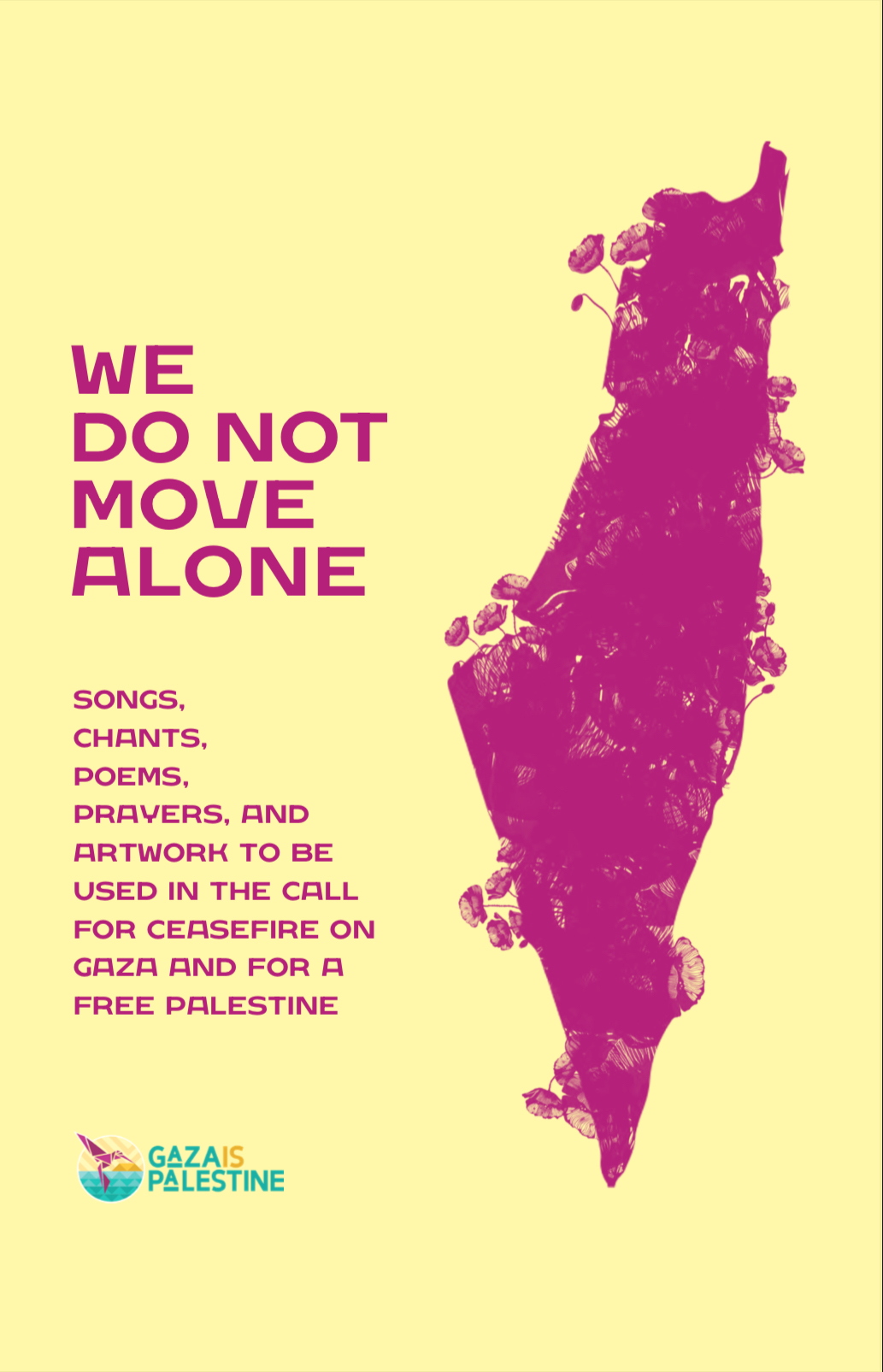
We wanted this resource to be as accessible as possible and to be used to unite folx who are rising up across lines of historic division so that we would not be manipulated and pitted against one another. This is why we were intentional in using various art mediums, languages, faith traditions, cultures, and sectors of movement. This is also why we altered the lyrics to “Courage,” using “we do not move alone” instead of the original “you do not walk alone”.
Our desire for the cultural arts guide is to not be used only by those who consider themselves “artists” but for those who want to engage in the movement for a permanent ceasefire, an arms embargo, and a free Palestine who may not have the words to express themselves. It’s also a way to bring folx from different backgrounds together. Included in the opening of the cultural book on page 5 is a piece that was written by the Peace Poets for a project with the Kairos Center on how to use song in movement that we expanded for this book for the broader engagement with art and culture tactically.
Courage, my friend
We do not move alone
We will move with you
And sing your spirit home
Check out “We Do Not Move Alone” Gaza is Palestine Ceasefire Cultural Arts book here.
Connection. The Kairos Center defines connection as the state of being united or joined, often in a network form of leaders and/or organizations. Connection also references the organic ties of leaders to a certain class or social strata. For us, this is the inextricable connection to the poor and dispossessed. We are in a battle of ideas that is an external struggle, but must also be taken up from within.
For those of us who have grown up in the U.S., we are steeped in a culture that not only oppresses us, but engrains ideologies that are counter to our values. This prevailing culture is used to manipulate and divide those who are hurting.
We are living in a time of immense and multiple crises of widespread poverty and dispossession, the rise of religious nationalism and white supremacy, ecological devastation, and increased militarism throughout the world. In societies ruled by those who put profit over people, Gaza should be understood as a canary in the coal mine for poor and dispossessed people in how a capitalist state may respond to a people it deems expendable.
In the United States, there are over 140 million people one paycheck away from economic ruin and it is estimated that about 800 people die a day from the impact of poverty alone. Everyday more people are being pushed into houselessness. Hospitals across the country are being privatized and closed. Access to free and proper education is being denied, voting rights shredded, and bodily autonomy being taken away in broad snatches. In rural towns and in cities there is a lack of clean water, breathable air, and healthy food. As we are constantly told that there aren’t enough resources to invest in life saving programs and institutions in our communities in the United States, our government sends at least $3.8 billion of our tax dollars in support of Israel’s brutal occupation of Palestinian people every year.
In preparing to launch the 1967 Poor People’s Campaign, Rev. Dr. Martin Luther King, Jr.shared in a series of lectures the need for unity among the poor and dispossessed to build a movement able to effect real change. He said:
“The dispossessed of this nation — the poor, both white and Negro — live in a cruelly unjust society. They must organize a revolution against that injustice, not against the lives of the persons who are their fellow citizens, but against the structures through which society is refusing to take means which have been called for, and which are at hand, to lift the load of poverty. The only real revolutionary, people say, is a man who has nothing to lose. There are millions of poor people in this country who have very little, or even nothing, to lose. If they can be helped to take action together, they will do so with a freedom and a power that will be a new and unsettling force in our complacent national life.”
Highlander Research and Education Center Cultural defines cultural organizing as the strategic use of art and culture to shift policies and practices with marginalized communities. Cultural strategy acknowledges existing ideologies and behaviors while promoting new ways of thinking that align with the movement’s goals. It operates on the premise that in order to change laws, policies, and social practices there first needs to be a change in how people think, feel, and relate to one another.

I carry with me a conversation I once had with Malka Roth of the Rising Majority about the experiences of the working-class communities (Jewish for Malka and Black for me) that we come out of being pitted against one another and the struggle for a liberated Palestine by myths of scarcity touted by those in power along with the fear of isolation from those we love for speaking out. Malka shared that she wished she could communicate that although it may seem scary, on the other side of the potential pain of losing one community, is actually the opportunity to join a vast and loving network of communities around the world in this struggle for liberation who are ready to know, love, and struggle alongside you. Moreover, it is only through our unity, fierce revolutionary love, and commitment to ending injustice everywhere that all of us may be free.
Courage, my friend
We do not move alone
We will move with you
And sing your spirit home
I recently shared this experience with a multi-racial group of faith-inspired social justice leaders from across the country who gathered during the Wild Goose Festival in North Carolina. You can check it out between 14:47- 17:45 here.
Commitment. The Kairos Center defines commitment in its highest and most developed form as the devotion or dedication of one’s life to building a social movement through uniting and developing leaders. I cannot believe that it has almost been a year since the genocide in Gaza has begun. Al Jazeera has recently reported that if the over 40,000 Palestinian people in Gaza who have been killed since October 7, 2023 “joined hands, standing apart, to form a human chain, they could surround the entire island of Manhattan.” More than 92,401 Palestinians in Gaza have been injured with another 10,000 reported missing. Everyday we are learning of increased settler violence in other occupied areas of Palestine and in the West Bank.
Having organized over a decade against the death-dealing systems of poverty, mass incarceration, and state violence in the United States, I know firsthand (and am currently navigating day by day) how overwhelming prolonged periods of uprise and struggle for justice can be. To bear witness to the daily massacre of Palestinians alongside the beginnings of famine, spread of infectious diseases, and structural damage that will impact generations to come in Gaza may cause some to lose faith in our movement and give up on the struggle for a just world.
I once asked Rev. John Mendez, a civil rights leader, retired pastor of Emmanuel Baptist Church (Winston-Salem, North Carolina), and clergy activist with the Poor People’s Campaign: A National Call for Moral Revival, how he has sustained in struggle throughout his decades of organizing. He shared with me that whenever he feels discouraged he will read biographies and writings of leaders of past liberation movements to learn how they were able to navigate troubling times and crises of their day. What I love about using songs in service of the movement is that singing is not only a way to unite leaders together in our current struggles but that songs are able to serve as a connective thread between generations of organizers, linking the struggles of the past to those of the present and future. When we teach and sing movement songs in the context of struggle today, we ground ourselves in a rich history of resistance and commit ourselves to carry this legacy and work forward.
“Courage” is a song that was created in the struggle against Apartheid in South Africa. Apartheid (meaning “apartness” in Afrikaans) was the legal system for racial separation in South Africa and South West Africa (now Namibia) officially between 1948 until 1994. Under the Apartheid system in South Africa, all areas of life—political, social, and economic—were ruled by this system. I am certain that there were times when leaders felt demoralized to the point of giving up, but fortunately they never did. Song was a powerful tool they wielded in order to maintain their unity and commitment to ending Apartheid in South Africa through assassinations of their leaders, widespread violence in their communities, and incarceration.

As part of an action last year that marked the beginning of a national week of action for a permanent ceasefire in Gaza, a free Palestine, and end weapons sales to Israel, the Kairos Center joined Adalah Justice Project, US Campaign for Palestinian Rights, Jewish Voice for Peace, Rising Majority, Movement 4 Black Lives, Dissenters, Grassroots Global Justice, Detention Watch Network, Little Sis, About Face: Veterans Against War, Action Center on Race and Economy (ACRE), and others in taking over the Hart Senate Office Building. Our call was for the US government to divest from militarism and to instead invest in the needs of the people in this country like healthcare, education, and housing. During our action, one of the organizers scaled a 51 foot sculpture to increase awareness, calling for congress to “Invest in Life, Not in Militarism.” In speaking with him after, he shared that once he got up the sculpture and knew that he would be there for a while. Feeling at a loss for what to say, he shared the one song that came to mind—“Courage”—and ad libbed other verses.
Courage, Palestine,
You do not walk alone
We will walk with you
and sing your struggle on
You can check out a video of Nico singing here.
I believe that all organizers should be cultural organizers because although people are driven into movement due to the conditions they face, it is not always enough to keep them in struggle for the long haul. The role of cultural organizing is to align our minds, hearts, and spirit with our values in order to build a movement—a social force that can bring about social change—across lines of historic division. Our task as cultural organizers is to develop other leaders with a consciousness that is rooted not only in their individual experiences but the experiences of all who are hurting so that we can build and fight for a collective vision for a just future.
As we continue to confront the violence and persecution faced by Palestinians and other oppressed communities worldwide, it is crucial to remember the lessons learned from our shared struggles. Solidarity, cultural organizing, and unwavering commitment are essential to building a powerful and effective movement for justice. Art and culture are not mere embellishments for our actions but central to our strategies for social change through developing leaders who are committed to the unity and struggle of all who are oppressed. By drawing on the lessons of past struggles and integrating art and culture into our strategies, we can strengthen our movements and work towards a more just and equitable world for all.
For more cultural resources from the Kairos Center for Religions, Rights, and Social Justice, click here.
